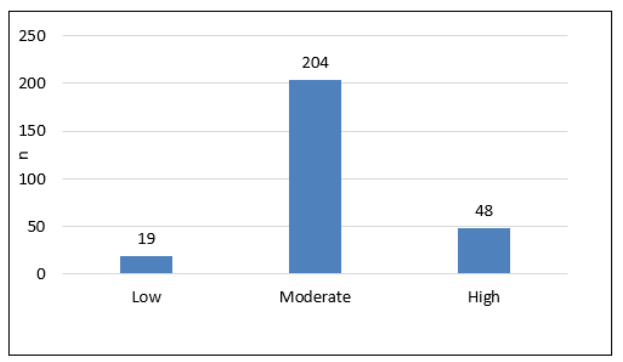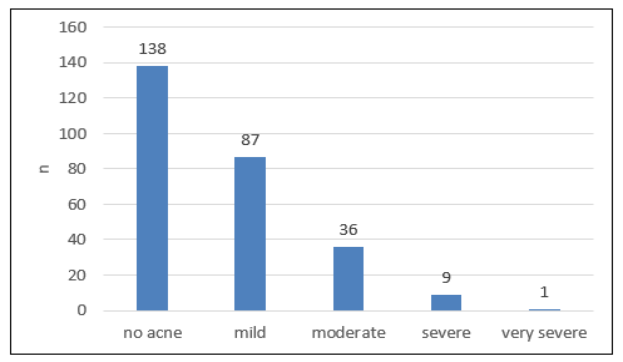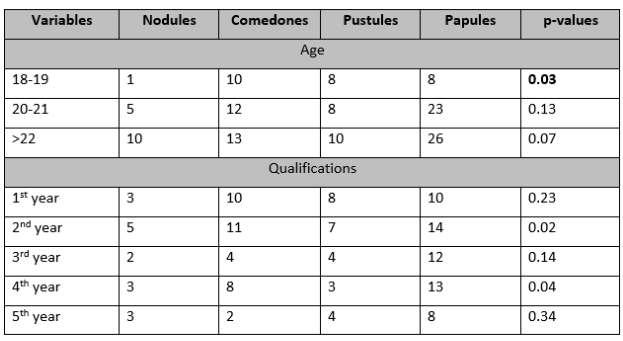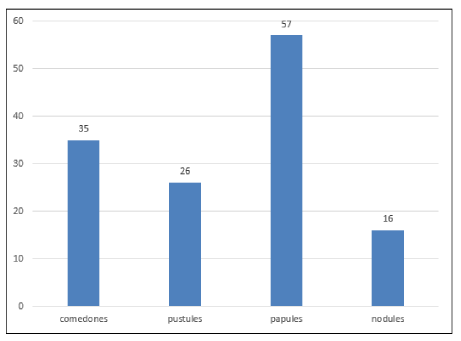By Shawana Sharif1, Samrah Tahir2, Asma Fatimah Malik2, Laiba Khan2, Wareesha Ijaz2, Rida Fatima2, Faizan Fazal2
- Dermatology Department, Benazir Bhutto Hospital, Rawalpindi, Pakistan
- Medicine Department, Rawalpindi Medical University, Rawalpindi, Pakistan
DOI: https://doi.org/10.36283/PJMD13-1/013
How to cite: Sharif S, Tahir S, Malik AF, Khan L, Ijaz W, Fatima R, Fazal F. Prevalence of Acne and its Association with Stress in Female Medical Students. Pak J Med Dent. 2024;13(1): 69-74. Doi: 10.36283/PJMD13-1/013
Background: Acne vulgaris is described as a chronic skin disease involving blockage and inflammation of pilosebaceous units. The objective of this study was to determine the prevalence of acne and its association with stress in female students.
Methods: This is a cross-sectional study carried out at Rawalpindi Medical University. The study included female medical students of all five years of MBBS excluding lactating and pregnant females and the ones who were diagnosed with skin disorders other than acne. The sample size was 271. A questionnaire consisting of PSS (Perceived Stress Scale) and GAGS (Global Acne Grading System) was used. Data was analyzed by using SPSS and basic statistics and Spearman correlation were applied.
Results: In this study, it was found that out of a total of 271 students, 138(50.9%) students didn’t have acne, and 133(49%) did have Acne. Out of a total of 271 students, 19 (7%) students had low stress, 204 students (75.3%) had moderate stress, and 48 students (17.7%) had high perceived stress. Out of 133 who were found to have acne, 87(32.1%) of the participants had mild acne, 36(13.3%) had moderate acne, 9(3.3%) had severe acne, and 1(0.4%) had very severe acne. An increase in stress severity was moderately correlated (r=0.393) with an increase in acne severity which was not statistically significant (p>0.05).
Conclusions: Almost half of the study population was found to have Acne. A positive correlation has been found between stress and acne indicating stress as one of the causative factors of acne.
Keywords: Acne, Stress, Female students.
Acne vulgaris is a common chronic skin condition that affects the sebaceous glands, including the hair follicles, and results in obstruction and irritation1. It affects nearly 90% of the male and 80% of the female adolescent population2. Stress is considered a predisposing factor for acne vulgaris.
According to a study done in Indonesia, there is a positive association between the stress scale and the severity of acne vulgaris3. A study carried out in Jeddah, Saudi Arabia, found that stress led to acne through several different processes. According to this study, stress has a favorable relationship with the severity of acne4. Research done in India shows that in adult females, acne was worsened by stress5. According to a study conducted in Singapore, there is a positive link between sebum production and acne severity when stress levels are high6. According to a study conducted in Pennsylvania, individuals were able to accurately identify their acne as the cause of their emotional suffering7.
A study conducted in Karachi reported that stress was one of the factors that triggered acne breakouts8. According to a study done in Uttar Pradesh, acne severity was directly correlated with depression and despair levels9. An investigation by medical students at SRMSIMS in India found a direct correlation between the severity of the acne, the degree of post-acne scarring, and the length of the disease for patients with acne vulgaris10. According to a study done at Ziauddin Medical University’s KDLB Campus in Karachi, acne is positively correlated with both despair and anxiety. It had an impact on one’s personality, feelings, sense of self-worth, social isolation, and capacity to build relationships11. According to a study done at the Quaid-i-Azam Medical College in Bahawalpur, comorbidities are particularly prevalent in dermatological clinics. Major co-morbid mental entities in dermatology patients were major depressive episodes, depression caused by a generalized anxiety disorder, and dysthymia12.
The purpose of this study was to evaluate the relationship between stress and acne vulgaris and to identify psychological stress as one of the causes of acne so that treatment strategies can be modified by stress levels and to help people change their attitude towards seeking psychological help. Fewer studies have been conducted on this topic in our locality, so we aim to research this topic.
A cross-sectional study based on convenient non-random sampling with a sample size of 271 (calculated by using a WHO calculator with a confidence interval of 95% and a margin of error of 5%) was conducted at Rawalpindi Medical University (ERC number: Psy-74-46-22). This study was done over 6 months. The female medical students enrolled in MBBS from first to final year were included except those who were already diagnosed with some skin disease disorder. The pregnant and lactating females were also excluded.
A structured questionnaire was circulated amongst the students to measure the degree of perceived stress4. A perceived stress scale was used to grade stress and a questionnaire consisting of 10 questions was used to grade stress as low, moderate, or high. The following scoring scheme was used: Score 0-13=mild; 14-26=moderate; 27-40=higher perceived stress. Using the Global Acne Grading System, the score for each area (local score) and global score which was the sum of all local scores was calculated. Acne severity was graded using a global score. A score of 1-18 was considered mild; 19-30, moderate; 31-38, severe; >39, very severe. Collected Data was entered and analyzed by statistical methods using version 26 of SPSS. Stress and acne severity were correlated using Spearman Correlation.
In this study, it was found that out of a total of 271 female students, 138(50.9%) students didn’t have acne, and 133(49%) had acne. Using the Perceived Stress Scale (PSS), it was evaluated that out of a total of 271 students, 19 (7%) students had low stress, 204 students (75.3%) had moderate stress, and 48 students (17.7%) had high perceived stress. This is shown in Figure 1.

Figure 1: Severity of stress.
Regarding the severity of acne using the Global Acne Grading System, 87(32.1%) of the participants had mild acne, 36(13.3%) had moderate acne, 9(3.3%) had severe acne, and 1(0.4%) had very severe acne. This is shown in Figure 2.

Figure 2: Prevalence and severity of acne in participants
Out of the 133(49%) participants that did have Acne, 57(43%) had papules, 35(26%) had comedones, 26(19%) had pustules, and 16(12%) had developed nodules.
Table 1: Prevalence of type of acne in age groups and different classes.

p-value <0.05 is considered significant.

Figure 3: Types of acne in patients diagnosed with acne
An increase in stress severity was moderately correlated (r=0.393) with an increase in acne severity which was not statistically significant (p value>0.05). Subjects having higher total stress scores on PSS had higher global acne scores on GAGS. A positive correlation was found between stress and acne severity using the Spearman correlation.
Acne vulgaris, with a worldwide prevalence of approximately 85%, is often associated with stress20. Various studies have been conducted to establish and study the correlation between stress and the development of acne vulgaris. This study has shown a moderately positive correlation between acne and stress (r=0.393, p>0.05) with females having higher stress scores showing higher acne grading.
However, a study conducted in Jeddah also established a positive correlation (r=0.23, p=0.01) between stress and acne. But stress alone is not a risk factor for acne. Other factors such as heat, humidity, hormonal changes, and cosmetic products seemed to aggravate acne in females and are known risk factors for the development of acne1.
Numerous other studies have been carried out to further assess the association between stress and the development of acne. A cohort study by Gil Yosipovitch et El Tang M also showed a positive correlation (r=0.23, p=0.029) between stress and acne papulo-pustulosa. Another Research also showed a positive correlation (r=0.456, p=0.001) between acne and stress with moderate strength. This observational study with a cross-sectional design involved 100 patients with acne vulgaris. The majority of subjects had moderate acne vulgaris followed by mild and severe. A low-stress scale followed by medium and high has been found. It concluded an association between stress scale and severity of acne3.
A prospective study examining factors triggering acne in adult females showed that lack of sleep and stress were observed in masses with high serum levels of androgens, suggestive of a vague link between stress and acne4. This study also focused on revealing the type of acne present in the female population of Rawalpindi. Papules are the most common type of acne that was present in the participants of this study. Nodules were the least common type of acne that was present in the participants of this study. It is important to know the type of acne prevalent in the population so that treatment preferences and a more focused approach can be implemented against that type of acne. A study conducted in India on a similar topic found that the popular type of acne was the most prevalent form of acne found in their population. They also found out that the cheek was the most prominent location involved in the acne patients13.
Regarding the severity of acne, most of the patients who had acne were found to have only a mild form of acne. Only 1 participant was found to be having a severe form of acne. Moreover, the stress severity was also assessed in this study. This study found that most of the participants had moderate levels of stress. A similar study conducted in Lebanon found that most of their population had a moderate form of acne 14. This is similar to what we have found in Pakistan through this study.
In a study performed in Australia among final-year medical students at the University of Melbourne, 67% of students identified stress as an exacerbating factor15. Another research postulated that in adult women with acne, chronic stress stimulates the secretion of androgens and results in sebaceous glands hyperplasia16. Peripheral nerves release the substance P or gastrointestinal peptide VIP in response to stress. Substance P stimulates the proliferation of sebaceous glands and upregulates lipid synthesis in sebaceous cells 17,18.
Despite the lack of support for a psychological etiology to acne, it is interesting to note that two-thirds of students believed that Stress played a major role in acne exacerbation. This is consistent with patient’s perceptions of stress as a causal factor of acne; a questionnaire survey of 178 patients reported that 74% believed that anxiety was an exacerbating factor 19. Another study found that enhanced stress levels exacerbated acne vulgaris20-22. Another study established a positive correlation between acne vulgaris and perceived stress levels23,24 and a pathogenetic link between stress and acne was postulated and studied25,26. A multicenter case-control study in Italy indicated that Acne was also linked to high or extremely high psychological stress levels in the month before the clinical test 27.
Variations in results can be attributed to other stress-aggravating factors such as heat, humidity, hormonal changes, menstruation, and use of cosmetic products which have not been taken into consideration in this study. Other factors can be small sample size, and differences in lifestyle and diet in different countries which can cause differences in results. An observational cohort study can contribute to better results.
Various studies prove the intimate relation of skin disorders with psychiatric illnesses which emphasizes the importance of an interdisciplinary approach involving dermatologists and psychiatrists leading to a biopsychosocial approach in dealing with and treating patients with skin diseases such as acne.
Stress is one of multiple factors which can trigger or worsen acne by a wide variety of mechanisms. No significant study was conducted in our region which showed a relationship between stress and acne severity. Based on this study, it is concluded that stress positively correlates with acne severity. Female students with higher stress scores had higher acne grades. So, one can prevent or treat acne by controlling the stress levels of individuals.
I would like to acknowledge the hospital staff for their immense contribution.
The authors declare no conflict of interest.
The study got its ethical approval from the institutional review board of Rawalpindi Medical University (Reference number: PSY-74-46-22).
All authors contributed equally.
- Ab Hadi H, Awadh A. Study of psychological stress and acne vulgaris among pharmacy students. Value in Health. 2015;18(3):A179-A180. https://doi.org/10.1016/j.jval.2015.03.1039
- Yosipovitch G, Tang M, Dawn AG, Chen M, Goh CL, Huak Y, Seng LF. Study of psychological stress, sebum production, and acne vulgaris in adolescents. Acta Derm Venereol. 2007;87(2):135-139. https://doi.org/10.2340/00015555-0231
- Sutrisno AR, Jusuf NK, Putra IB. Correlation between stress scale and severity of acne vulgaris. Bali Medical Journal. 2020;9(1):376-379. https://dx.doi.org/10.15562/bmj.v9i1.1749
- Zari S, Alrahmani D. The association between stress and acne among female medical students in Jeddah, Saudi Arabia. Clinical, cosmetic and investigational dermatology. 2017;10:503. https://doi.org/10.2147/CCID.S148499
- Bansal P, Sardana K, Vats G, Sharma L, Garga UC, Khurana A. A prospective study examining trigger factors and hormonal abnormalities in adult female acne. Indian Dermatology Online Journal. 2020;11(4):544. https://doi.org/10.4103%2Fidoj.IDOJ_500_19
- Walton S, Wyatt EH, Cunliffe WJ. Genetic control of sebum excretion and acne – a twin study. Br J Dermatol 1988; 118:393–396. https://doi.org/10.1111/j.1365-2133.1988.tb02433.x
- Koo JYM. The psychosocial impact of acne: patients’ perceptions. J Am Acad Dematol 1995: 32: S26–S30. https://doi.org/10.1016/0190-9622(95)90417-4
- Batool S, Sohail S, Yasmeen G, Iqbal N, Naz L, Shamim M. Acne vulgaris leading to psychosocial problemsamong youth of Karachi. Int. J. Endorsing Health Sci. Res. 2019. Doi:10.29052/IJEHSR.v7.i2.2019.93-100
- Parwez S, Zainab SR, Andaleeb S. Self-Esteem And Social Anxiety Among Face Acne Patients In Peshawar. Multicultural Education. 2023;9(3). Doi: 10.5281/zenodo.7719384.
- Levy LL, Zeichner JA. Management of acne scarring, part II: a comparative review of non-laser-based, minimally invasive approaches. American journal of clinical dermatology. 2012;13:331-340. https://doi.org/10.2165/11631410-000000000-00000
- Clark S. An exploration of emotional distress in adults with acne (Doctoral dissertation, University of East London). https://doi.org/10.15123/PUB.5411
- Yadav S, Narang T, Kumaran MS. Psychodermatology: A comprehensive review. Indian journal of dermatology, venereology, and leprology. 2013;79:176. doi: 10.4103/0378-6323.107632
- Shah N, Shukla R, Chaudhari P, Patil S, Patil A, Nadkarni N, Goldust M. Prevalence of acne vulgaris and its clinico‐epidemiological pattern in adult patients: Results of a prospective, observational study. Journal of cosmetic dermatology. 2021;20(11):3672-3678. https://doi.org/10.1111/jocd.14040
- Kaikati J, Zoghaib S, Kechichian E, Stephan F, Helou J, Sleilaty G, Tomb R. The impact of acne treatment on quality of life and self-esteem: A prospective cohort study from Lebanon. International Journal of Women’s Dermatology. 2021;7(4):415-421. https://doi.org/10.1016/j.ijwd.2021.03.005
- Green J, Sinclair RD. Perceptions of acne vulgaris in final year medical student written examination answers. Australas J Dermatol. 2001;42(2):98–101. https://doi.org/10.1046/j.1440-0960.2001.00489.x
- Kligman AM. Post-adolescent acne in women. Cutis. 1991;48:75–77.
- Todoya M, Morohashi M. New aspects in acne inflammation. Dermatology. 2003;206:17–23. https://doi.org/10.1159/000067818
- Zouboulis CC. Neuroendocrine regulation of the sebaceous gland. Experimental Dermatology. 2004;13(9):569. https://doi.org/10.1111/j.0906-6705.2004.00212k.x
- Rasmussen J, Smith S. Patient concepts and misconceptions about Acne. Arch. Dermatol. 1983; 119: 570–572. doi:10.1001/archderm.1983.01650310032006
- Sachdeva M, Tan J, Lim J, Kim M, Nadeem I, Bismil R. The prevalence, risk factors, and psychosocial impacts of acne vulgaris in medical students: a literature review. International Journal of Dermatology. 2021;60(7):792-798. https://doi.org/10.1111/ijd.15280
- Bin Saif GA, Alotaibi HM, Alzolibani AA, et al. Association of psychological stress with skin symptoms among medical students. Saudi Med J. 2018;39(1):59-66. doi:10.15537/smj.2018.1.21231
- Aziz F, Khan MF. Association of Academic Stress, acne symptoms and other physical symptoms in medical students of King Khalid University. International Journal of Environmental Research and Public Health. 2022;19(14):8725. https://doi.org/10.3390/ijerph19148725
- Jusuf NK, Putra IB, Sutrisno AR. Correlation Between Stress Scale and Serum Substance P Level in Acne Vulgaris. Int J Gen Med. 2021;14:681-686. doi: 10.2147/IJGM.S294509.
- Li X, He C, Chen Z, Zhou C, Gan Y, Jia Y. A review of the role of sebum in the mechanism of acne pathogenesis. J Cosmet Dermatol. 2017;16(2):168-173. doi:10.1111/jocd.12345
- Zouboulis CC, Böhm M. Neuroendocrine regulation of sebocytes–a pathogenetic link between stress and acne. Experimental dermatology. 2004;13:31-35. https://doi.org/10.1111/j.1600-0625.2004.00254.x
- Shannon JF. Why do humans get acne? A hypothesis. Med Hypotheses. 2020;134:109412. doi:10.1016/j.mehy.2019.109412
- Di Landro A, Cazzaniga S, Cusano F, Bonci A, Carla C, Musumeci ML, Patrizi A, Bettoli V, Pezzarossa E, Caproni M, Fortina AB, Campione E, Ingordo V, Naldi L; Group for Epidemiologic Research in Dermatology Acne Study Group. Adult female acne and associated risk factors: Results of a multicenter case-control study in Italy. J Am Acad Dermatol. 2016;75(6):1134-1141.e1. doi: 10.1016/j.jaad.2016.06.060.
This is an open-access article distributed under the terms of the CreativeCommons Attribution License (CC BY) 4.0 https://creativecommons.org/licenses/by/4.0/
